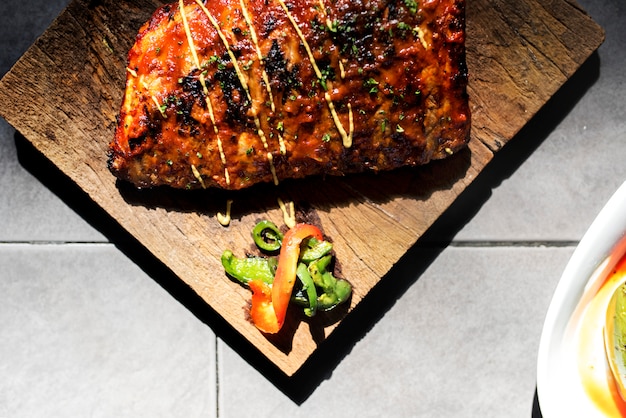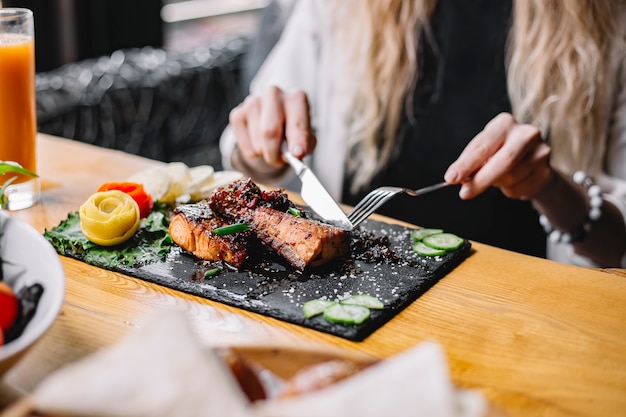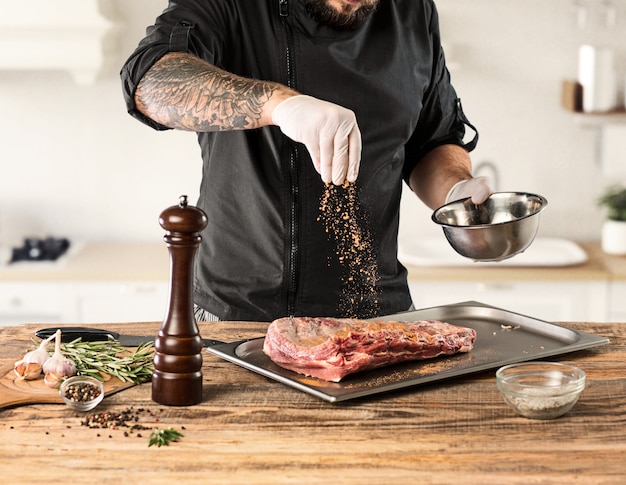Let's face it, there's something about a prime rib roast that just screams "special occasion." It's the kind of dish that makes your house smell heavenly and brings a sense of occasion to any gathering. But for years, I shied away from making it, thinking it was too complicated or that I wouldn't get it right. But then, one day, I decided to take the plunge. I dove headfirst into the world of prime rib, and let me tell you, it was an absolute revelation! It's not as intimidating as it seems, and the reward of that perfectly cooked, juicy, melt-in-your-mouth roast is absolutely worth it.
(Part 1) The Star of the Show: Choosing Your Prime Rib

The first step, of course, is choosing the prime rib itself. And this is where you don't want to skimp. We're talking about the heart of the dish, the foundation for a delicious feast. You want a good quality cut, and I highly recommend going for a bone-in roast. Those bones do more than just look fancy; they add a depth of flavour and help the meat stay juicy. Look for a roast that's marbled with fat - that beautiful white marbling throughout. It's what'll make it melt-in-your-mouth delicious. Think of it like the culinary equivalent of a well-balanced investment portfolio. You want that fat to play its part!
Now, size matters. If you're feeding a family of four, a 3-4 pound roast will likely do the trick. But if you're planning a feast for a crowd, then you'll need something bigger, perhaps a 6-8 pound behemoth. And don't be afraid to ask your butcher for advice. They're the experts, they know their cuts, and they can help you choose the perfect roast for your needs. Remember, this is a special occasion roast, so go big or go home!
choosing the right cut: A Breakdown
There are different cuts of prime rib, each with its own unique characteristics. Here's a quick rundown:
- standing rib roast: This is the classic choice, a three-bone section that's perfect for a large group. It's usually the most expensive, but it's worth it for the rich flavour and tender texture. Imagine a culinary crown jewel - it's that good.
- Rib Roast: This cut is a little less expensive than the standing rib roast and comes with two bones. It's still a great choice for a large gathering, and you won't have to break the bank. It's like the sensible cousin of the standing rib roast, just as delicious but a little more budget-friendly.
- English Roast: This cut comes from the middle section of the rib and has a single bone. It's a good option for smaller groups, a more intimate gathering where you can really focus on the flavour.
- Crown Roast: This fancy cut is made by removing the rib bones and shaping the meat into a crown. It's visually stunning and perfect for special occasions. Imagine a culinary masterpiece that would make even the most sophisticated palate swoon.
(Part 2) Prepping Your Prime Rib for Perfection

Now that you've got your beautiful piece of meat, it's time to prep it. I like to start by patting it dry with some kitchen paper. This helps ensure a nice crispy sear on the outside, a beautiful contrast to the juicy, tender interior. Then, I give it a good rub with some salt and pepper. This is your basic seasoning, the foundation of flavor, the simple but essential building blocks of a delicious dish. You can get fancy with other spices later, but salt and pepper are the backbone of the roast.
Adding Flavor with Herbs and Spices: A Smorgasbord of Options
Now, this is where you get to unleash your inner chef. There's a whole world of possibilities when it comes to herbs and spices. I love using a blend of rosemary, thyme, garlic powder, and onion powder. It gives the roast a classic, comforting aroma, like a warm hug in culinary form. But you can add whatever you like, be it paprika, cayenne pepper, or even a touch of ginger. Don't be afraid to experiment and create your own signature blend. Remember, cooking is an art, and you're the artist.
(Part 3) Roasting Your Prime Rib to Perfection

Now comes the exciting part: roasting. I like to use a dutch oven for this, but you can also use a roasting pan. You want to make sure you have enough space for the roast to sit comfortably, allowing the heat to circulate evenly and create a beautiful, even roast. Preheat your oven to 450°F (230°C) - we want a good sear, a crisp exterior that will entice your guests.
Searing the Prime Rib: The Key to a Crispy Exterior
Right, time for the sear! Place the roast in the hot oven and cook for 15-20 minutes, making sure to rotate it every 5 minutes. This will create a beautiful crust on all sides, locking in the juices and giving you that gorgeous, golden-brown finish. You'll know it's ready when the outside is a lovely golden brown. It's a glorious moment, the smell of roasted meat filling the air!
The Low and Slow Approach: Cooking for Tenderness
After the sear, it's time to lower the temperature to 325°F (160°C). This is where patience is key. We're going for that melt-in-your-mouth tenderness, and that takes time. Think of it like a slow dance, a gradual transformation from a hearty roast to a symphony of flavors. How long you cook the roast depends on the size and your desired level of doneness.
Doneness: Finding Your Perfect Level
Here's where we need to talk about doneness. Rare, medium-rare, medium, medium-well, well-done - it's all a matter of personal preference. And there's no right or wrong answer here, it's about finding what you enjoy most. Here's a guide to help you decide:
| Doneness | internal temperature (°F) |
|---|---|
| Rare | 125-130°F |
| Medium-Rare | 130-135°F |
| Medium | 135-140°F |
| Medium-Well | 140-145°F |
| Well-Done | 145°F and above |
Checking for Doneness: The meat thermometer's Role
To ensure perfect doneness, it's crucial to use a meat thermometer. Insert it into the thickest part of the roast, avoiding the bone. You want the internal temperature to reach your desired level. It's like checking the temperature of a delicate soufflé, ensuring it's cooked perfectly.
(Part 4) Resting the Prime Rib: A Crucial Step
Okay, the roast is cooked! But don't be tempted to carve it right away. We need to let it rest, which is crucial for redistributing the juices. Think of it as a moment of relaxation after a long workout, allowing the meat to recover and retain its moisture. Cover the roast loosely with foil and let it rest for at least 15-20 minutes. This will allow the meat to relax and the juices to redistribute, resulting in a much more tender and flavorful roast.
(Part 5) Carving the Prime Rib: A Culinary Art
After resting, it's time to carve the prime rib. This is where the artistry comes in. Start by removing the roast from the Dutch oven or roasting pan. Place it on a cutting board and slice it against the grain. The grain runs along the length of the muscle fibers, so cutting against it will result in tender, bite-sized pieces.
The Importance of Cutting Against the Grain
Why is cutting against the grain so important? Because it breaks down the muscle fibers, making the meat more tender and easier to chew. Imagine chewing on a piece of string - that's what happens when you cut with the grain. Cutting against the grain makes it like chewing on a soft, fluffy cloud - a much more pleasant experience, wouldn't you agree?
(Part 6) Accompaniments: Elevating the Prime Rib Experience
Now, no prime rib roast is complete without its accompaniments. This is where your culinary creativity can really shine. Think roasted vegetables, creamy mashed potatoes, gravy, and even a simple salad.
Roasted Vegetables: A Rainbow of Flavors
Roasted vegetables are a must-have side dish. They add a burst of color and flavour to your plate, a symphony of textures and tastes that complement the richness of the prime rib. Some of my favorites include Brussels sprouts, carrots, asparagus, and potatoes.
creamy mashed potatoes: A Comforting Classic
Mashed potatoes are the ultimate comfort food. They're creamy, delicious, and pair perfectly with prime rib. It's like a warm hug on a plate, a comforting counterpoint to the savory richness of the roast.
Gravy: The Finishing Touch
Don't forget the gravy! It adds a rich, savory flavour to the whole dish, pulling everything together into a delicious symphony. You can make a simple gravy from the pan drippings or go for a more elaborate version with a thickening agent like cornstarch or flour. It's like a culinary hug, binding everything together.
(Part 7) Serving Your prime rib masterpiece
Right, your prime rib is carved, your sides are ready, and your table is set. Now, it's time to serve this masterpiece! Place a generous portion of prime rib on each plate, followed by your chosen sides. You can also offer condiments like horseradish and Dijon mustard to enhance the flavour.
A Festive Presentation: Making It Special
Remember, presentation is key! Place the roast on a beautiful platter, surrounded by colorful vegetables and a generous pool of gravy. Your dining experience will be elevated from a simple meal to a culinary delight. It's like showcasing a beautiful piece of art, a celebration of the senses.
(Part 8) The Afterglow: Enjoying Your Culinary Creation
And there you have it! Your prime rib masterpiece is ready to be enjoyed. Take a moment to savor the aroma, the taste, and the company. It's a dish that's meant to be shared, a testament to your culinary skills and a celebration of good food and good company.
Sharing the Joy: A Culinary Triumph
As you gather around the table, raise a glass to the success of your prime rib roast. It's a dish that brings people together, creating memories that will last a lifetime. And who knows, you might even inspire someone to try their hand at this classic culinary feat.
FAQs
Here are some frequently asked questions about prime rib roast:
Q: Can I cook prime rib in a slow cooker?
A: While it's not the traditional way to cook prime rib, you can certainly use a slow cooker. Just sear the roast first to get a crispy crust, then transfer it to the slow cooker and cook on low for 6-8 hours. This is a great option for a hands-off approach, perfect for busy days.
Q: How long should I cook prime rib for?
A: The cooking time depends on the size of the roast and your desired level of doneness. As a general guide, plan on about 15-20 minutes per pound for rare, 20-25 minutes per pound for medium-rare, and 25-30 minutes per pound for medium. Use a meat thermometer to ensure the roast is cooked to your liking. It's like a culinary timer, ensuring your roast is perfectly cooked.
Q: What can I do with leftover prime rib?
A: Leftover prime rib is a culinary treasure! You can use it to make sandwiches, salads, or even a delicious prime rib hash. It's like a culinary gift that keeps on giving, offering endless possibilities for delicious meals.
Q: How do I reheat prime rib?
A: The best way to reheat prime rib is in a low oven at 325°F (160°C). Heat it for about 15-20 minutes, or until it's heated through. You can also reheat it in the microwave, but it won't be as flavorful. It's like a gentle reawakening, bringing the roast back to life without sacrificing its deliciousness.
Q: What is the best way to store prime rib?
A: Store leftover prime rib in an airtight container in the refrigerator for up to 4 days. You can also freeze it for up to 3 months. To freeze, wrap it tightly in plastic wrap and aluminum foil. It's like a culinary time capsule, preserving the deliciousness of the roast for later enjoyment.
Everyone is watching

Corn on the Cob: The Ultimate Guide to Perfectly Cooked Ears
Healthy MealsAh, corn on the cob. Just the name evokes images of sunny days, barbecues, and that sweet, juicy flavour that ...

Perfect Pork Roast Oven Cooking Time: A Guide to Delicious Results
Healthy MealsThere's something truly satisfying about a perfectly roasted pork. The aroma alone is enough to make your mout...

Scallops: The Ultimate Guide to Perfect Cooking
Healthy MealsAh, scallops. Those delicate, sweet, and utterly delicious morsels of the sea. They hold a special place in my...

Ham Cooking Time: How Long to Bake, Smoke, or Boil a Delicious Ham
Healthy MealsAh, ham. It's a classic, isn't it? A real crowd-pleaser, especially around holidays. And when done right, it'...

Spaghetti Squash: The Ultimate Guide to Cooking and Serving
Healthy MealsRemember that time you saw spaghetti squash at the supermarket, looking all bumpy and strange, and thought, "W...
